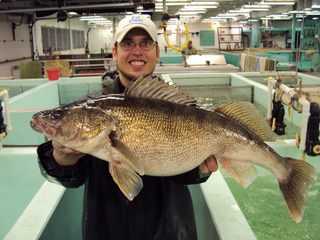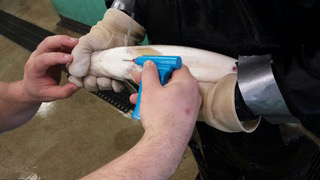Anglers enjoy walleye in two places: on the end of a line beneath glassy water and crackling in hot spattering oil lathered in batter. Walleye possess inherent sporting qualities and their value as table fare is beyond compare.
 |
Fishery management biologists have intense interest in walleye conservation and that interest is manifest in recent research in tag retention funded through excise taxes paid by manufacturers of fishing gear and on motor boat fuels. The U.S. Fish and Wildlife Service’s Wildlife and Sport Fish Restoration Program administers such research grants via Federal Aid in Sport Fish Restoration.
Marking and recapturing fish later is an essential fish management technique in understanding current and projected populations and the outcomes past management actions, such as creel limits and size limits.
Iowa Department of Natural Resources biologist Jonathan Meerbeek at the Spirit Lake Research Station embarked on a five-year-long study on how walleye retain passive integrated transponders, or PIT tags. PIT tags are not unlike a microchip carried by your cat or dog to identify your pet should it become lost.
Meerbeek said that previous techniques such as an elastic tag tucked under the jaw just under the skin was time-consuming and expensive and was not as reliable as scientists would prefer. The tags often fell out over time, thus rendering the effort useless for those fish that no longer carried the jaw tag.
The walleye in northwestern Iowa are of particular concern to Meerbeek and his colleagues, not only for the fact that they provide quality walleye fishing, but they are the source for brood stocks in state-operated hatcheries.
“We strive to maintain walleye in Iowa’s ‘great lakes’ for brood stock sources,” said Meerbeek. “Maintaining good tabs on walleye 17 inches and larger is really important, and the more reliable the tagging data, all the better for the fish and fishing.”
 |
Most tag-retention studies for any fish species rarely go beyond a couple of years, according to Meerbeek. His research findings, which he recently published in the Journal of Fish and Wildlife Management revealed that PIT tags injected between the pelvic fins, yielded high long-term retention rates.
In 2015, Meerbeek and his colleagues planted PIT tags in walleye and those in the study set recaptured as recent at 2019 retained the PIT tags, signaling that the method has great utility for the needs of Iowa’s biologists and anglers and or other long-term walleye research where tagging is a necessity.
“PIT tags are efficient and economical and the subsequent population modeling data coming from walleye tagged between the pelvic fins is robust,” said Meerbeek.
And there is an added benefit from the research. The fillet knife usually bypasses the pelvic fin musculature so PIT tags are unlikely to show up in the skillet or the plate.
— Craig Springer
Springer is with the United States Fish and Wildlife Service’s Wildlife and Sport Fish Restoration Program